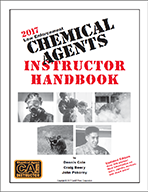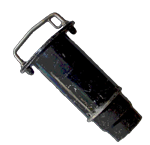The non-lethal chemical agent of choice for law enforcement varies depending upon the circumstances an officer is faced with. Each type agent has it strengths and weaknesses.
CN is the agent that has fallen out of favor for a number of reasons. CN has one strength that is does not out weigh its weaknesses. That one strength is that when exposed to the heat of a person’s skin it begins to transform and form a vapor cloud that will surround a suspect. That means that where ever you get the chemical on the skin it will form that vapor cloud. That same cloud is a draw back to its use. When we’ve used an aerosol and we approach the subject to take him into custody we traditionally enter the same cloud and  experience the same exposure as the suspect. Those cross contaminations made it unpleasant for officers to use their personal can of CN so they didn’t use it on a regular basis. In those instances where an officer has no other alternative the fight was on. The result was usually someone being injured. Another more serious drawback to the use of CN is the allergic reactions some people may experience resulting from the exposure to CN. About every one in 1,000 people may break out in a rash and in more serious exposures receive chemical type lesions/burns on the skin. If these lesions are not treated immediately they can lead to serious infections. CN is more toxic than other non-lethal chemical agents we traditionally use in law enforcement. That means that if a suspect is exposed to the agent long enough he may die from toxic poisoning. I.E. The amount it takes to die from over exposure is less than what it takes to die from over exposure to CS.
experience the same exposure as the suspect. Those cross contaminations made it unpleasant for officers to use their personal can of CN so they didn’t use it on a regular basis. In those instances where an officer has no other alternative the fight was on. The result was usually someone being injured. Another more serious drawback to the use of CN is the allergic reactions some people may experience resulting from the exposure to CN. About every one in 1,000 people may break out in a rash and in more serious exposures receive chemical type lesions/burns on the skin. If these lesions are not treated immediately they can lead to serious infections. CN is more toxic than other non-lethal chemical agents we traditionally use in law enforcement. That means that if a suspect is exposed to the agent long enough he may die from toxic poisoning. I.E. The amount it takes to die from over exposure is less than what it takes to die from over exposure to CS.
CS has its own strengths and weaknesses. CS has replaced CN for most law enforcement agencies because of its increased effectiveness and less toxicity than CN. It takes far less CS to effect a human being than it takes of CS. That alone makes it safer to use. Combined with the U.S. Army’s medical studies showing that it is less toxic as a chemical than CN. CS has enhanced symptoms over CN or OC. As we all know non-lethal chemical agents depend on a person’s psychological reactions. The feelings that one  gets after being exposed to CS usually leads to a pause in combat. The person almost always starts thinking about the feeling being developed in his body and not the officer or any other activity. There have not been any allergic reactions attributed to the exposure to CS. However, repeated exposure can lead to building a tolerance for it making it less effective. Not many criminals are exposed to CS enough to build up that tolerance. Because of the small particle size CS stays “persistent”. That means that it stays airborne the longest of all the chemicals. This persistence leads to a faster more prolonged exposure. CS is the nonlethal chemical agent of choice for removing a suspect from inside a structure. That persistence and cloud of agent allows for more psychological effects than other agents.
gets after being exposed to CS usually leads to a pause in combat. The person almost always starts thinking about the feeling being developed in his body and not the officer or any other activity. There have not been any allergic reactions attributed to the exposure to CS. However, repeated exposure can lead to building a tolerance for it making it less effective. Not many criminals are exposed to CS enough to build up that tolerance. Because of the small particle size CS stays “persistent”. That means that it stays airborne the longest of all the chemicals. This persistence leads to a faster more prolonged exposure. CS is the nonlethal chemical agent of choice for removing a suspect from inside a structure. That persistence and cloud of agent allows for more psychological effects than other agents.
OC is the newest of the agents used by law enforcement. Although we have been using it since the early 1990’s we still have a lot to learn about it. OC is a naturally occurring substance found primarily in the pepper plant. There have been many studies both pro and con about the possible dangers of  the use of the substance. The biggest disadvantage at this time is that there have been no long-term health studies concerning the use of the substance. There have been many short-term looks at the efficacy of its use. The majority of these studies feel that there is no health risk involved in the amounts we use in law enforcement. On the plus side Capsaicin, the ingredient in OC that makes it hot, has been used in pharmaceuticals for many years. Some people are allergic to pepper. Use of OC on them can result in anaphylactic shock. On the plus side we have very little cross contamination compared to CN or CS with OC. If you are using powdered OC there is even less cross contamination. Unlike CS and CN there has been no scientific studies giving us the toxic levels of exposure. A study on mice being injected with OC has a lethal dose recorded. So how much is enough? We don’t know. The biggest advantage we have using OC is that our officers feel confident in its use, don’t get a lot of cross contamination and are using it instead of other levels of force. Anytime we can reduce injuries we have a win and the use of OC has definitely given us that win.
the use of the substance. The biggest disadvantage at this time is that there have been no long-term health studies concerning the use of the substance. There have been many short-term looks at the efficacy of its use. The majority of these studies feel that there is no health risk involved in the amounts we use in law enforcement. On the plus side Capsaicin, the ingredient in OC that makes it hot, has been used in pharmaceuticals for many years. Some people are allergic to pepper. Use of OC on them can result in anaphylactic shock. On the plus side we have very little cross contamination compared to CN or CS with OC. If you are using powdered OC there is even less cross contamination. Unlike CS and CN there has been no scientific studies giving us the toxic levels of exposure. A study on mice being injected with OC has a lethal dose recorded. So how much is enough? We don’t know. The biggest advantage we have using OC is that our officers feel confident in its use, don’t get a lot of cross contamination and are using it instead of other levels of force. Anytime we can reduce injuries we have a win and the use of OC has definitely given us that win.





